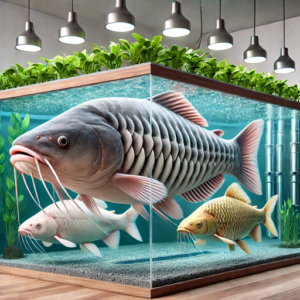
Aquaponics with Tilapia, Channel Catfish, and Gold Tilapia: A Fun Dive into Sustainable Farming!
Ever wanted your own little slice of nature right in your backyard—complete with fish and plants working together like they’ve signed a peace treaty? Welcome to aquaponics, a mini ecosystem that’s the perfect mash-up of aquaculture (fish farming) and hydroponics (growing plants without soil). It’s like a win-win for both fish and veggies, with fish doing their part by providing nutrient-rich waste (thanks, fish!) while plants help clean the water. A match made in aquaponic heaven!
Fish Species in Aquaponics
Tilapia: The Aquaponics MVP
Let’s start with the tilapia, the gold standard of aquaponics. This little guy is tough, fast-growing, and pretty much eats whatever you throw at it. It’s like having the least fussy roommate ever. And in return, they help grow your plants faster. Plus, they taste pretty darn good on your plate! Talk about an all-star!
Channel Catfish: The Tank Custodian
Next, meet the channel catfish, your waterway janitor. These bottom-dwelling, whiskered fellas are built for cooler waters, making them perfect for those who don’t live in tropical paradise year-round. They’re super efficient at turning food into body mass, which means they’ll give your plants all the nutrients they need. And if you’re a catfish and cornbread fan, you’re in for a treat!
Gold Tilapia: The Bling of the Tank
Looking for a little flash? Enter gold tilapia—like regular tilapia but dressed to impress. These golden beauties are perfect if you want to add a little “wow” factor to your aquaponics system. Plus, they come with the same hardy, fast-growing traits as their regular cousins. They’re great conversation starters or even a unique selling point if you’re thinking of going pro.
Setting Up Your Aquaponics System
Essential Components
Okay, now that you’re sold, let’s get this show on the road. You’ll need a fish tank, a grow bed, and a pump to keep things moving—basically, your own backyard water cycle. Don’t forget the filters—your plants will do some of the work, but you might need extra help to keep the water crystal clear. It’s like a little aquarium and garden all in one!
Designing Your Layout
Pro tip: make sure you can actually reach everything! No one likes doing a balancing act to feed their fish or pick some lettuce. Also, use vertical space! Stack those plants up and turn a small footprint into a high-rise veggie tower. Think strawberries on the top floor, lettuce in the middle—it’s a plant party!
Water Quality Management
Here’s where you get to feel like a scientist! You’ll need to keep an eye on water quality—testing for pH, ammonia, nitrites, and nitrates is key. Trust me, it’s not as hard as it sounds, and soon you’ll be doing it like a pro. Keeping a log of your tests will help you spot any changes before things go sideways. Good water equals happy fish and thriving plants!
Best Practices for Fish Care
Feeding Your Fishy Friends
Feeding time is a highlight of any aquaponics system. Your fish will practically jump for joy when it’s chow time! But here’s the trick: don’t overdo it. A good rule of thumb? Only feed them what they can gobble up in five minutes. Think of it as portion control – for fish. If you’re feeling fancy, you can even feed them duckweed or other aquatic plants for a little gourmet touch.
Maintaining Fish Health
Your fish might not talk, but they’ll definitely show you when something’s wrong. Keep an eye out for odd swimming patterns, changes in appetite, or strange colors—these are fishy red flags. If something’s off, it’s time for action. Quarantine any sick fish to avoid spreading disease. And remember, prevention is the best medicine: good water quality, enough space, and a balanced diet will keep your fish in tip-top shape.
Challenges and Solutions in Aquaponics
Common Issues
Like any good adventure, aquaponics has its challenges. Balancing the nutrients between your fish and plants can sometimes feel like juggling flaming torches. Too much fish waste? Your plants may drown in nutrients. Not enough? Your veggies will look like they’ve been on a crash diet.
Troubleshooting Tips
If you run into trouble, don’t throw in the towel! Adjust your fish-to-plant ratio until you find the sweet spot. For pests, stick to natural solutions like neem oil or introducing beneficial insects. The fewer chemicals, the better—for both your fish and the planet.
Conclusion
Diving into aquaponics with tilapia, channel catfish, and gold tilapia is like opening a secret door to the future of sustainable farming. Whether you’ve got a green thumb or can barely keep a cactus alive, aquaponics offers something for everyone. It’s not just about growing food—it’s about creating your very own thriving ecosystem.
So, go ahead and give it a whirl. Before you know it, you’ll be harvesting your own home-grown salad and maybe even some fried catfish to go with it. Plus, just think about how impressed your friends will be when they see you’ve mastered this whole fish-and-veggies-growing thing. Happy farming, folks!
FAQs
- Can I mix different fish species?
It’s possible, but mixing species can make things tricky. Different fish have different needs, and it’s generally simpler to stick with one kind per system. - How long does it take for an aquaponics system to cycle?
Usually, it takes about 4-6 weeks to fully cycle, which gives beneficial bacteria time to establish. - Can I use tap water?
Sure! Just make sure to dechlorinate it first—chlorine is a fishy no-no. - What’s a good plant to start with?
Leafy greens like lettuce and spinach are great starters—they’re low-maintenance and grow quickly. - How often should I clean the system?
While your system will mostly take care of itself, regular maintenance, such as removing solid waste and trimming plants, is key.
Aquaponics With Tilapia, Channel Catfish, and Gold Tilapia
